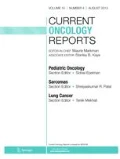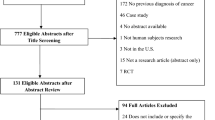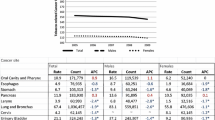Abstract
Although public health efforts have dramatically reduced the prevalence of smoking in the past several decades, smoking remains the leading cause of preventable morbidity and mortality in the United States. Moreover, tobacco use is becoming increasingly concentrated among individuals with the lowest levels of education, income, and occupational status. Profound racial/ethnic and socioeconomic status (SES) disparities exist for tobacco-related cancer incidence and mortality, and for access to and quality of cancer treatment. Furthermore, racial/ethnic minority and low SES smokers have greater difficulty quitting smoking, are less likely to use effective resources for quitting, and have limited access to evidence-based cessation treatments. Widespread implementation of population-based tobacco cessation approaches may have had the unintended effect of increasing tobacco-related cancer health disparities. It is crucial that vulnerable populations of smokers be provided with effective and accessible treatments for tobacco dependence, as this would have a profound impact on reducing tobacco-related cancer health disparities.
Similar content being viewed by others
References and Recommended Reading
Mokdad AH, Marks JS, Stroup DF, et al.: Actual causes of death in the United States, 2000. JAMA 2004, 291:1238–1245.
American Cancer Society: Cancer Facts and Figures 2008. Atlanta, GA: American Cancer Society, 2008.
Centers for Disease Control: Cigarette smoking among adults—United States, 2007. MMWR Morb Mortal Wkly Rep 2008, 57:1221–1226.
Wardle J, Steptoe A: Socioeconomic differences in attitudes and beliefs about healthy lifestyles. J Epidemiol Community Health 2003, 57:440–443.
Jha P, Peto R, Zatonski W, et al.: Social inequalities in male mortality, and in male mortality from smoking: indirect estimation from national death rates in England and Wales, Poland, and North America. Lancet 2006, 368:367–370.
Honjo K, Tsutsumi A, Kawachi I, et al.: What accounts for the relationship between social class and smoking cessation? Results of a path analysis. Soc Sci Med 2006, 62:317–328.
Ward E, Jemal A, Cokkinides V, et al.: Cancer disparities by race/ethnicity and socioeconomic status. CA Cancer J Clin 2004, 54:78–93.
Wisnivesky JP, McGinn T, Henschke C, et al.: Ethnic disparities in the treatment of stage I non-small cell lung cancer. Am J Respir Crit Care Med 2005, 171:1158–1163.
Centers for Disease Control: Health disparities experienced by Hispanics—United States. MMWR Morb Mortal Wkly Rep 2004, 53:535–537.
US Census Bureau: An older and more diverse nation by midcentury. 2008. Available at http://www.census.gov/Press-Release/www/releases/archives/population/012496.html. Accessed July 22, 2009.
Willsie SK, Foreman MG: Disparities in lung cancer: focus on Asian Americans and Pacific Islanders, American Indians and Alaska Natives, and Hispanics and Latinos. Clin Chest Med 2006, 27:441–452, vi.
American Cancer Society: Cancer Facts & Figures for African Americans, 2007–2008. Atlanta, GA: American Cancer Society; 2007.
Zhu SH, Pulvers K, Zhuang Y, et al.: Most Latino smokers in California are low-frequency smokers. Addiction 2007, 102(Suppl 2):104–111.
Clark PI, Gautam S, Gerson LW: Effect of menthol cigarettes on biochemical markers of smoke exposure among black and white smokers. Chest 1996, 110:1194–1198.
Williams JM, Gandhi KK, Steinberg ML, et al.: Higher nicotine and carbon monoxide levels in menthol cigarette smokers with and without schizophrenia. Nicotine Tob Res 2007, 9:873–881.
Perez-Stable EJ, Herrera B, Jacob P 3rd, et al.: Nicotine metabolism and intake in black and white smokers. JAMA 1998, 280:152–156.
Levinson AH, Perez-Stable EJ, Espinoza P, et al.: Latinos report less use of pharmaceutical aids when trying to quit smoking. Am J Prev Med 2004, 26:105–111.
Fu SS, Kodl MM, Joseph AM, et al.: Racial/ethnic disparities in the use of nicotine replacement therapy and quit ratios in lifetime smokers ages 25 to 44 years. Cancer Epidemiol Biomarkers Prev 2008, 17:1640–1647.
Doty MM: Hispanic Patients’ Double Burden: Lack of Health Insurance and Limited English: Task Force on The Future of Health Insurance. New York: The Commonwealth Fund; 2003.
Centers for Disease Control: Cigarette smoking among adults: United States, 2000. MMWR Morb Mortal Wkly Rep 2002, 51:642–645.
Fiore MC, Novotny TE, Pierce JP, et al.: Trends in cigarette smoking in the United States. The changing influence of gender and race. JAMA 1989, 261:49–55.
American Cancer Society: Cancer Prevention and Early Detection, Facts and Figures, 2008. Atlanta, GA: American Cancer Society; 2008.
Kotz D, West R: Explaining the social gradient in smoking cessation: it’s not in the trying, but in the succeeding. Tob Control 2009, 18:43–46.
Abidoye O, Ferguson MK, Salgia R: Lung carcinoma in African Americans. Nat Clin Pract Oncol 2007, 4:118–129.
Morse DE, Kerr AR: Disparities in oral and pharyngeal cancer incidence, mortality and survival among black and white Americans. J Am Dent Assoc 2006, 137:203–212.
Berger M, Lund MJ, Brawley OW: Racial disparities in lung cancer. Curr Probl Cancer 2007, 31:202–210.
Bach PB, Schrag D, Brawley OW, et al.: Survival of blacks and whites after a cancer diagnosis. JAMA 2002, 287:2106–2113.
Gadgeel SM, Severson RK, Kau Y, et al.: Impact of race in lung cancer: analysis of temporal trends from a surveillance, epidemiology, and end results database. Chest 2001, 120:55–63.
Bach PB, Cramer LD, Warren JL, et al.: Racial differences in the treatment of early-stage lung cancer. N Engl J Med 1999, 341:1198–1205.
Cote ML, Kardia SL, Wenzlaff AS, et al.: Risk of lung cancer among white and black relatives of individuals with early-onset lung cancer. JAMA 2005, 293:3036–3042.
Leistikow BN, Tsodikov A: Cancer death epidemics in United States black males: evaluating courses, causation, and cures. Prev Med 2005, 41:380–385.
Samet JM, Wiggins CL, Key CR, et al.: Mortality from lung cancer and chronic obstructive pulmonary disease in New Mexico, 1958–82. Am J Public Health 1988, 78:1182–1186.
American Cancer Society: Cancer Facts & Figures for Hispanics/Latinos 2006–2008. Atlanta, GA: American Cancer Society; 2007.
Broder S: Progress and challenges in the National Cancer Program. In Origins of Human Cancer: A Comprehensive Review. Edited by Brugge J CT, Harlow E, McCormick F. Plainview, NY: Cold Springs Harbor Press; 1991.
Chu KC, Miller BA, Springfield SA: Measures of racial/ethnic health disparities in cancer mortality rates and the influence of socioeconomic status. J Natl Med Assoc 2007, 99:1092–1100, 1102–1094.
Thorndike AN, Biener L, Rigotti NA: Effect on smoking cessation of switching nicotine replacement therapy to over-the-counter status. Am J Public Health 2002, 92:437–442.
Cokkinides VE, Halpern MT, Barbeau EM, et al.: Racial and ethnic disparities in smoking-cessation interventions: analysis of the 2005 National Health Interview Survey. Am J Prev Med 2008, 34:404–412.
Centers for Disease Control: Achievements in public health, 1900-1999: tobacco use, United States, 199021999. MMWR Morb Mortal Wkly Rep 1999, 48:986–993.
Centers for Disease Control: Surveillance for Cancers Associated with Tobacco Use-United States, 1999–2004. MMWR Morb Mortal Wkly Rep 2008, 58:1–33.
Kanjilal S, Gregg EW, Cheng YJ, et al.: Socioeconomic status and trends in disparities in 4 major risk factors for cardiovascular disease among US adults, 1971–2002. Arch Intern Med 2006, 166:2348–2355.
Frohlich KL, Potvin L: Transcending the known in public health practice: the inequality paradox: the population approach and vulnerable populations. Am J Public Health 2008, 98:216–221.
Satcher D: Overlooked and underserved: improving the health of men of color. Am J Public Health 2008, 98:S139–S141.
Abrams DB: A comprehensive smoking cessation policy for all smokers: systems integration to save lives and money. In Ending the Tobacco Problem: A Blueprint for the Nation. Edited by Bonnie RJ, Stratton K, Wallace RB. Washington, DC: Institute of Medicine: National Academies Press; 2007:appendix A.
Jaen CR, Cummings KM, Shah D, et al.: Patterns of use of a free nicotine patch program for Medicaid and uninsured patients. J Natl Med Assoc 1997, 89:325–328.
Fiore MC, Jaen CR, Baker TB, et al.: Treating Tobacco Use and Dependence: 2008 Update. Rockville, MD: US Department of Health and Human Services (USDHHS), Public Health Service (PHS); 2008.
Borland R, Segan CJ: The potential of quitlines to increase smoking cessation. Drug Alcohol Rev 2006, 25:73–78.
Sussman S, Valente TW, Rohrbach LA, et al.: Translation in the health professions: converting science into action. Eval Health Prof 2006, 29:7–32.
Glasgow RE, Vogt TM, Boles SM: Evaluating the public health impact of health promotion interventions: the REAIM framework. Am J Public Health 1999, 89:1322–1327.
Kerner J, Rimer B, Emmons K: Introduction to the special section on dissemination: dissemination research and research dissemination: how can we close the gap? Health Psychol 2005, 24:443–446.
Centers for Disease Control: Telephone Quitlines: A Resource for Development, Implementation, and Evaluation. Atlanta, GA: Centers for Disease Control and Prevention, Department of Health and Human Services, National Center for Chronic Disease Prevention and Health Promotion, Office on Smoking and Health; 2004.
Author information
Authors and Affiliations
Corresponding author
Rights and permissions
About this article
Cite this article
Vidrine, J.I., Reitzel, L.R. & Wetter, D.W. The role of tobacco in cancer health disparities. Curr Oncol Rep 11, 475–481 (2009). https://doi.org/10.1007/s11912-009-0064-9
Published:
Issue Date:
DOI: https://doi.org/10.1007/s11912-009-0064-9




